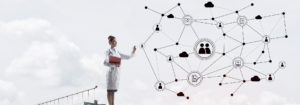
By Scott Hampel
Many challenges face healthcare’s underserved. There are issues with food, housing, reliable transportation, steady employment and more.
Each contributes to and is one element of social determinants of health (SDH). In communities around the world, public and private organizations are taking steps to address SDH-related issues and challenges that negatively impact healthcare.
For the healthcare industry to find its way to new and innovative SDH programs and to identify those who may benefit, they must be found. While some organizations use referrals following face-to-face meetings with prospective program members, predictive analytics can be utilized to identify many potential enrollees quickly and efficiently, as well.
The data could come from a variety of healthcare or socioeconomic sources
“Analytical capabilities in healthcare can be used to identify patterns of care and discover associations from massive healthcare records, thus providing a broader view for evidence-based clinical practice,” according to an article published in Technological Forecasting & Social Change. “Healthcare analytical systems provide solutions that fill a growing need and allow healthcare organizations to parallel process large data volumes, manipulate real-time, or near real time data, and capture all patients’ visual data or medical records. In doing so, this analysis can identify previously unnoticed patterns in patients….”
Predictive analytics uses a large dataset and an algorithm to, in this instance, identify people who may benefit from help. The data could come from a variety of healthcare or socioeconomic sources, including healthcare facilities and community organizations, and might contain information about:
- Wellness
- Chronic conditions
- Food
- Transportation
- Billing codes
The nonprofit eHealth Initiative identified data as crucial to understanding SDOH. “The importance of SDOH data in contributing to the complete picture of individuals and communities cannot be underestimated,” according to the organization.
An issue, however, is the slow adoption of predictive analytics in the healthcare industry. “(R)ecent developments in data analytics also suggest barriers to change that might be more substantial in the health care field than in other parts of the economy,” according to an article published by Brookings. “Despite the immense promise of health analytics, the industry lags behind other major sectors in taking advantage of cutting-edge tools.”
Get our take on industry trends
Why It’s Time for Healthcare to Move Toward AI Reporting
Business intelligence (BI) was a dramatic and significant step forward in healthcare industry reporting and a natural transition to artificial intelligence (AI) enabled real-time insights.
Read on...Why Healthcare Should “Double-Down” on Exploring AI-powered BI for Reporting
Many areas in healthcare rely not only on the collection of data but, importantly, the ability to decipher and act upon it. In that intersection, reporting was born.
Read on...Why Health Plans and Employers Need Stop Loss Reporting
Due to rising healthcare costs and the Affordable Care Act removing the ban on capitated benefits coverage, numerous employers with self-insured health plans often purchase stop loss coverage. This coverage is not medical insurance; but rather, it’s a financial and risk management tool that protects the employer from excessive claims.
Read on...Bridge the Payer/Provider Data Gap
Every patient has a plethora of data associated with their health record, which can include decades of enrollments, claims, accounts and charges. Much of this data is not housed within the same institutional, facility or provider database…
Read on...


